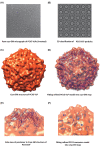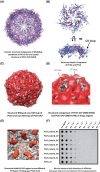Structural insight into the type-specific epitope of porcine circovirus type 3
- PMID: 32458997
- PMCID: PMC7295619
- DOI: 10.1042/BSR20201109
Structural insight into the type-specific epitope of porcine circovirus type 3
Abstract
The recently identified pathogenic Porcine circovirus type 3 (PCV3) may threaten to reduce the pig population dramatically worldwide. In our previous study, a PCV3-specific monoclonal antibody (mAb-1H11) was successfully applied in immune-histochemistry staining and ELISA, which specifically recognize PCV3 capsid protein in PCV3-positive pig tissues. In the present study, we expressed and purified the soluble sole capsid protein of PCV3. The purified capsid protein was capable of self-assembly into virus-like-particles (VLPs), which is validated by transmission electron microscopy and dynamic light scattering assays. Moreover, the epitope of mAb-1H11 was identified in the CD-loop region (a.a. 72-79) on the VLP surface, which is confirmed by PCV2-PCV3 epitope swapping assay. For the first time, we determined the cryo-EM structure of PCV3-VLP at 8.5 Å resolution that reveals the detailed structural information of PCV3-VLP. In our cryo-EM structure, PCV3-VLP is composed of 60 capsid protein subunits assembled with T = 1 icosahedral symmetry. Consistent to our bio-dot Western blot assay, the structural comparison between PCV3 and PCV2 revealed significant structural differences in the surface-exposed loops, including the CD-loop (a.a. 72-79) and the EF-loop (a.a. 109-131). Our work provides a structural framework for engineering future PCV3 vaccine and diagnosis kits development.
Keywords: Porcine circovirus type 3 (PCV3); capsid protein; cryo-EM structure; prophylactic vaccine; type-specific epitope; virus-like-particle (VLP).
© 2020 The Author(s).
Conflict of interest statement
The authors declare that there are no competing interests associated with the manuscript.
EM Data Bank: The cryo-EM structure of PCV3-VLP has been deposited to EMDB with the accession codes
Figures



Similar articles
-
Structural roles of PCV2 capsid protein N-terminus in PCV2 particle assembly and identification of PCV2 type-specific neutralizing epitope.PLoS Pathog. 2019 Mar 1;15(3):e1007562. doi: 10.1371/journal.ppat.1007562. eCollection 2019 Mar. PLoS Pathog. 2019. PMID: 30822338 Free PMC article.
-
Fine mapping of linear B cell epitopes on capsid protein of porcine circovirus 3.Appl Microbiol Biotechnol. 2020 Jul;104(14):6223-6234. doi: 10.1007/s00253-020-10664-2. Epub 2020 May 22. Appl Microbiol Biotechnol. 2020. PMID: 32445000
-
Neutralization Mechanism of a Monoclonal Antibody Targeting a Porcine Circovirus Type 2 Cap Protein Conformational Epitope.J Virol. 2020 Apr 16;94(9):e01836-19. doi: 10.1128/JVI.01836-19. Print 2020 Apr 16. J Virol. 2020. PMID: 32075932 Free PMC article.
-
Porcine Circovirus Type 3: Diagnostics, Genotyping, and Challenges in Vaccine Development.Transbound Emerg Dis. 2023 Sep 28;2023:8858447. doi: 10.1155/2023/8858447. eCollection 2023. Transbound Emerg Dis. 2023. PMID: 40303716 Free PMC article. Review.
-
Recent progress on porcine circovirus type 3.Infect Genet Evol. 2019 Sep;73:227-233. doi: 10.1016/j.meegid.2019.05.009. Epub 2019 May 13. Infect Genet Evol. 2019. PMID: 31096019 Review.
Cited by
-
Colorimetric Kit for Rapid Porcine Circovirus 2 (PCV-2) Diagnosis.Pathogens. 2022 May 12;11(5):570. doi: 10.3390/pathogens11050570. Pathogens. 2022. PMID: 35631091 Free PMC article.
-
Advances in Crosstalk between Porcine Circoviruses and Host.Viruses. 2022 Jun 28;14(7):1419. doi: 10.3390/v14071419. Viruses. 2022. PMID: 35891399 Free PMC article. Review.
-
Preparation of Monoclonal Antibodies against the Capsid Protein and Development of an Epitope-Blocking Enzyme-Linked Immunosorbent Assay for Detection of the Antibody against Porcine Circovirus 3.Animals (Basel). 2024 Jan 11;14(2):235. doi: 10.3390/ani14020235. Animals (Basel). 2024. PMID: 38254404 Free PMC article.
-
Novel Porcine Circoviruses in View of Lessons Learned from Porcine Circovirus Type 2-Epidemiology and Threat to Pigs and Other Species.Viruses. 2022 Jan 27;14(2):261. doi: 10.3390/v14020261. Viruses. 2022. PMID: 35215854 Free PMC article. Review.
-
Revisiting Porcine Circovirus Infection: Recent Insights and Its Significance in the Piggery Sector.Vaccines (Basel). 2023 Jul 31;11(8):1308. doi: 10.3390/vaccines11081308. Vaccines (Basel). 2023. PMID: 37631876 Free PMC article. Review.
References
-
- Zhang H.H. et al. . (2019) Novel circovirus species identified in farmed pigs designated as Porcine circovirus 4, Hunan province, China. Transbound Emerg. Dis. 67, 1057–1061 - PubMed
Publication types
MeSH terms
Substances
LinkOut - more resources
Full Text Sources

